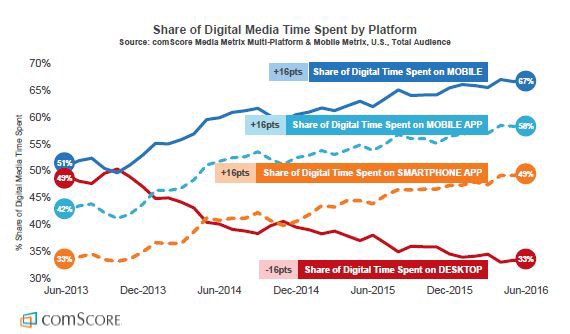It seems every 2017 Event Trends list I read features Chatbots and Artificial Intelligence (AI). So what’s driving this? Having followed emerging technology trends over the last year, I think it’s likely these five trends are responsible:
Trend #1 — Era of Mobile: Increasingly our population has become mobile-centric. Think about it…when was the last time you went anywhere without your smartphone?

Trend #2 — App Fatigue: While we are spending more time on our smartphones, we are downloading fewer and fewer apps. In fact, nearly half of us now download zero apps per month. Too much friction for too little value.
Trend #3 — Rise of Messaging Apps: In the last two years, companies have focused on establishing a presence on social networks like Facebook, Twitter, Pinterest and Instagram; however, messaging apps including WhatsApp, Facebook Messenger, WeChat and Kik have far surpassed those social networks in terms of the number of active users per month. Messaging apps have become the new second home screen.

Trend #4 — Artificial Intelligence (AI): No longer the bastion of academia, AI has entered the private sector. According to CB Insights, investments in AI have tripled in the last three years and we are starting to see AI-based products and services, like Amazon’s Echo and Apple’s Siri, becoming mainstream. The AI winter is over.
Trend #5 — Age of the Customer: 71% of customers, up 7 points from 2015, now prefer to self-serve to solve customer service issues. And when they do contact a business, they want it to be a text-based communication (like messaging, live chat, social media) not voice. Today’s empowered, time-starved customers want immediate value and will go elsewhere if their needs are not met.
Which brings me to chatbots…
Let’s start with a quick definition. Chatbots are software programs that include AI components to interact with people over messaging apps. Early uses for today’s chatbots have typically been for practical purposes such as customer service or information acquisition, however, businesses are now beginning to see that there are tremendous opportunities to use chatbots to personalize content delivery and have meaningful conversations with their customers at scale. Why? To answer this, let’s look at chatbots in the context of the trends. Chatbots:
- Are accessible and easy to interact with on mobile devices
- Do not require users to download a new app (pretty safe assumption given 92–100% of US adults text daily)
- Live on existing messaging apps that have billions of active users (SMS, Facebook Messenger, Telegram, Kik, WeChat, Viber and more)
- Leverage AI for their domain of knowledge and ability to personalize conversations
- Are text-based, self-service available 24x7x365
And now chatbots specifically for events…
So now that we understand what chatbots are and their appeal, let’s consider their application for events.
Accessibility: Attendees can use their favorite messaging app to connect with an event chatbot. Or, if you have their permission the chatbot can reach out to the attendee and start the conversation. Text messaging is familiar and easy to use for attendees; there’s no app to download and nothing new to learn.
Information and Resources: Chatbots aren’t constrained to just text. Their conversations can include images, links, emoji’s, stickers, menus, buttons and cards to present event information and resources in a rich and engaging way. Chatbot conversations can include: event agendas, speaker bios including links to LinkedIn profiles, venue maps, sponsor information, exhibit hall maps, deep links to Google or Waze driving directions, etc. It’s pretty much whatever information and resources your attendees need, a chatbot can deliver!
Notifications: Event staff can use chatbots to deliver notifications to attendees. These can be for scheduled reminders, like the opening keynote is starting or transportation for the evening activity is leaving. Notifications can also be ad-hoc alerts, such as a particular session is filling up or there has been a speaker change.
Engagement: Chatbots are not only great at providing information but they can collect it! They can ask survey questions to gather feedback and insights. Poll attendees and present results to keep them engaged during a presentation. And crowd source questions for a speaker or panel.
Personalized Conversations: Every event has different types of participants with different information needs. Chatbots can personalize their conversation by type of participant. The chatbot can converse with attendees, speakers, sponsors, etc. about their specific information needs. Conversations can also be personalized at an individual participant level using information made available from other event systems.
Support: Attendees can use the chatbot to submit requests for human assistance, like the room is too hot, we’re out of ice water, etc. The chatbot can alert the event staff and the need can be addressed with minimal disruption to the event.
Community: A chatbot’s conversation can change over time which can be a powerful tool for building community. The focus of the conversation can be different before, during and more importantly, after the event. Reach out to attendees with additional information and resources. Let them know about regional events or an upcoming webinar that they might be interested in. Crowd source topics for next year’s event. The possibilities are limitless!
BTW — one chatbot can include all of the above, you don’t need to hire a team of them!
Conclusion
Chatbots are here! And they are already starting to redefine the way companies interact with customers. They’re opening up new opportunities to connect, collaborate, learn and innovate. Are you ready to redefine how you interact with your attendees?


